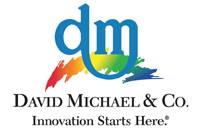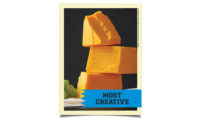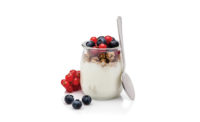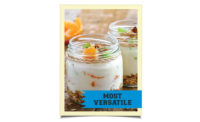Sponsored by:

You probably thought that as 2015 drew to a close, you could look back and say, “Clean labeling: I remember back when that was a thing.” Silly you.
Well, it still is a “thing,” and so much of one that for the third year running, it’s the thing — the main theme — driving development in and applications for new ingredient technologies. As Donna Klockeman, senior principal food scientist for TIC Gums, White Marsh, Md., put it, “The ‘clean’ and ‘simple’ trends that began in other food and beverage categories are expanding across the industry, and more customers across the dairy sector are interested in moving toward a clean or simple ingredient system.”
Indeed, researchers at Innova Market Insights found that more than 20% of the 2014 domestic product launches it tracked were tooting their clean-label horns, versus 17% the year prior. And that curve kept moving upward and to the right in 2015. In fact, most industry watchers think it’s time we stop calling clean labeling a trend and start seeing it for what it is: reality. So with more clean sweeteners, texturizers, cultures and proteins coming on line in 2015, it was another banner year for label-friendly ingredients.
Bottom-up movement
It’s worth noting that absent amidst all the clean-label action this year was any establishment of a standard definition as to what the phenomenon actually is. Such a standard would go far toward putting all the parties — consumers, suppliers, manufacturers and regulators — on the same page. But until the Food and Drug Administration speaks, dairy developers and their ingredient partners are left with their ears to the ground, listening for signals from consumers.
As well they should. Clean labeling is largely a bottom-up movement. As Mark Cornthwaite, dairy industry team lead, DuPont Nutrition & Health, New Century, Kan., put it, “Consumers are paying more attention to ingredient labels than ever before, and they want to recognize and understand the ingredients in the products they buy.”
This is especially true of Millennial parents with young children who are “supporting this trend through their willingness to pay more for all-natural products,” said Amy Loomis, business development manager, food, Synergy Flavors, Wauconda, Ill.
Cleaner sweeteners
So what does this mean for dairy developers? Reformulation. Consider sweeteners. Consumers are demanding “cleaner” forms and lower use levels, especially in child-friendly products like flavored milks, yogurts and desserts. That has developers looking for “natural, noncaloric sweeteners that offer great taste and a sweetness profile that’s close to that of sucrose,” said Ivan Gonzales, dairy marketing director, Ingredion Inc., Westchester, Ill.
Afrouz Naeini agreed. The senior marketing manager for sweetness at Ingredion has seen industry’s toolbox expand with “the introduction of new stevia-based sweeteners, sweetness taste-modulation technologies, simpler sources of sweetness” — think honey, syrups, fruits and vegetables — “and the introduction of rare sugars.”
One such rarity is coconut sugar, which “experienced a surge in popularity in 2015,” according to Thom King, president, Steviva Ingredients, Portland, Ore. He expects it to do the same in 2016, when his company will unveil a stevia-fortified coconut sugar.
Monk fruit extract, another trendy high-intensity sweetener that hit markets several years back, was also “a prevailing story that grew legs at tradeshows this year,” King said, especially in blends with stevia, “where the correct combination of the two masks the off notes in each individual sweetener.” He predicts falling prices will make monk fruit a viable option for dairy food manufacturers.
But zero-calorie stevia had no trouble dominating clean-sweetener headlines on its own, with the number of new products in which it appeared seeing double digit growth, year-on-year, since 2009. Stevia is in the mainstream, said Pam Stauffer, global marketing programs manager, Cargill, Minneapolis. But even stevia sweeteners have their drawbacks, including bitter notes and an aftertaste at high levels that can constrain their broader use.
A viscous circle
As Naeini put it, the challenge remains balancing taste and formula cost. And texture. Product developers are “also seeking a broad range of clean-label texturizers,” she said.
The fact is, “Consumers don’t consider formulation stability requirements” when inspecting labels, said Marshall Fong, global consumer insights director, FMC Health and Nutrition, Philadelphia. “They expect a thick and creamy texture in their Greek yogurt, for example. And the onus is on us — suppliers and manufacturers — to achieve a finished product that suits both consumer taste and label preference,” he said.
Cultured perspective
In some cases, dairy developers may not even need texturizers to build mouthfeel into their products. Cornthwaite predicted that cultures and enzymes “will play a very large role” in texturizing cleanly.
Mirjana Curic-Bawden Ph.D., principal scientist, application manager, fermented milk and probiotics, cultures & enzymes, Chr. Hansen, Milwaukee, added that strategic culture selection can help manufacturers “deliver high viscosity in stirred yogurt or a smooth texture in drinking yogurt without added stabilizers.” And to reduce added sugars, she suggested “releasing lactose’s sweetness by way of lactase enzyme action and yogurt cultures.”
Curic-Bawden has also noticed processors using cultures to create “a range of ethnic products” now making their way into dairy cases, from kefir to lassi to Indian dahi. “Almost all fall either under the yogurt category or are similar to buttermilk or sour cream,” she said. Targeted cultures are even giving a few oldies-but-goodies, like cottage cheese, new life.
“It’s been a challenge attracting younger generations to [cottage cheese],” Curic-Bawden noted. “A smoothed cottage cheese that was recently launched in Canada looks set to break through that barrier.”
Putting protein to work
While clean labels made most of the news this year, it wasn’t the only theme guiding ingredient developments. Protein fortification was also “a key 2015 trend,” Fong noted. “Consumers are seeking even higher levels of protein in their products, like Greek and Icelandic yogurts and fitness or muscle-recovery shakes, which poses a challenge in terms of formulation, especially for texture.”
Protein’s hardcore adherents are softening up to include “civilians” along with bodybuilders and athletes, making broader functionality a real R&D boon. Already, “one of the most prevalent developments of 2015” has been “intermediate-protein fortification for everyday consumers,” said Loren Ward, director of R&D, Glanbia Nutritionals, Fitchburg, Wis.
For instance, a sports-nutrition shake might deliver 25-plus grams of protein per bottle, while a fruit-and-dairy smoothie may top out at 5 grams. Finding the middle ground between the two “results in a hybrid product that still offers indulgent appeal but at 5 to 15 grams of protein,” Ward said.
Merging technology and creativity to fill a need is a sign of things to come.
“There are multiple ways of getting to the right sensory profile,” Fong said. “It’s never the ingredient itself, but a combination of technical expertise in formulation and an understanding of how the final products come together with the proper processing techniques to allow us to deliver an orchestra of attributes.”
Milk | Cheese | Cultured | Ice Cream | Butter | Non-dairy Beverages | Ingredients | Exports




